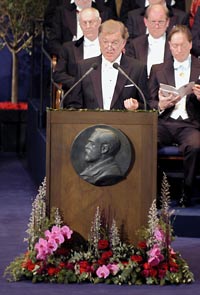Award ceremony speech
Presentation Speech by Professor Sten Grillner of the Nobel Assembly at Karolinska Institutet, December 10, 2004.
 |
| Professor Sten Grillner delivering the Presentation Speech for the 2004 Nobel Prize in Physiology or Medicine at the Stockholm Concert Hall. Copyright © Nobel Media AB 2004 Photo: Hans Mehlin |
Your Majesties, Your Royal Highnesses, Ladies and Gentlemen,
We perceive the world through our senses – we enjoy the brilliant colours around us, we listen to well-known sounds in the environment, but we also experience the world through a symphony of scents. We can perceive no less than 10,000 different smells, at this very moment not only the flowers from Nobel’s Sanremo, but also perfumes and other fragrance. Soon we shall enjoy this evening’s dinner, in particular the sense of smell will help us identify the gastronomic subtleties, and evaluate the qualities of the wines. A scent from our childhood can make us remember long forgotten memories, the tar of the fishing-boats from long ago, or the scent of honeysuckle rose. The sense of smell is in some way more primitive than other senses – less verbal – often we do not have words to describe the qualities of a new smell. If our sense of smell is damaged, however, we lose much of our quality of life – life becomes greyer – the food does not taste – but we will survive. For most animals, the sense of smell is a matter of life and death. A newborn pup finds its mother with the help of olfactory cues – without the sense of smell, no survival.
For a long time, it has been known that the olfactory receptor cells are located far up in the nose, and that they send their thin neural processes through small canals in the bone directly to the part of the brain called the olfactory bulb. Many important details of how the sense of smell is designed were also known, but up to the elegant studies of Richard Axel and Linda Buck that we award here today, the basic mode of operation of the sense of smell was not understood. In their studies on mouse, they showed that no less than 3% of the genes were coding for olfactory receptors – docking stations for different odorants. They are large molecules located in the cell membrane of the olfactory cells that react to different odorants that pass through the nose. This large gene family “manufactures” around 1000 different types of docking stations, each of which responds to only a few odorants. It was subsequently shown that each type of olfactory cell only expresses a single type of docking station in its cell membrane. In the mouse there are thus 1000 different types of olfactory receptor cells. For each type, there are a large number of copies spread in the mucosa of the nose.
I will now shift over to the lingua franca of science.
The mouse thus has no less than 1,000 different types of receptor cells or sensors that react to different odorants. In humans some of the genes have degenerated and we may have as little as 350 types of sensors. The olfactory world of a mouse or a dog is most likely, infinitely richer than our own. Nevertheless our sense of smell adds importantly to our quality of life. Each population of receptor cells sends their processes to the same specific micro-regions in the olfactory bulb, which in turn relays the information to the next set of nerve cells. They project to the cortical regions concerned with the perception of smell. In technical terms there is a “labelled line” from each receptor subtype to the cortex, which thus will be continuously informed about the degree of activation of each of the many subtypes of receptors.
Each characteristic scent is, as a rule, a mix of odorant molecules that activates a combination of different sensors – types of receptor cells that send their signal via the olfactory bulb to the cortex. The specific combinatorial code that reaches the cortex makes us perceive a given odorant. Richard Axel and Linda Buck have unravelled the enigma of our ability to discern so many different scents.
Professors Axel and Buck,
On behalf of the Nobel Assembly at Karolinska Institutet, I wish to convey to both of you our warmest congratulations for having unravelled the function of one of our senses, the olfactory system. You will now receive the Nobel Prize from the hands of His Majesty the King.
Nobel Prizes and laureates
See them all presented here.
